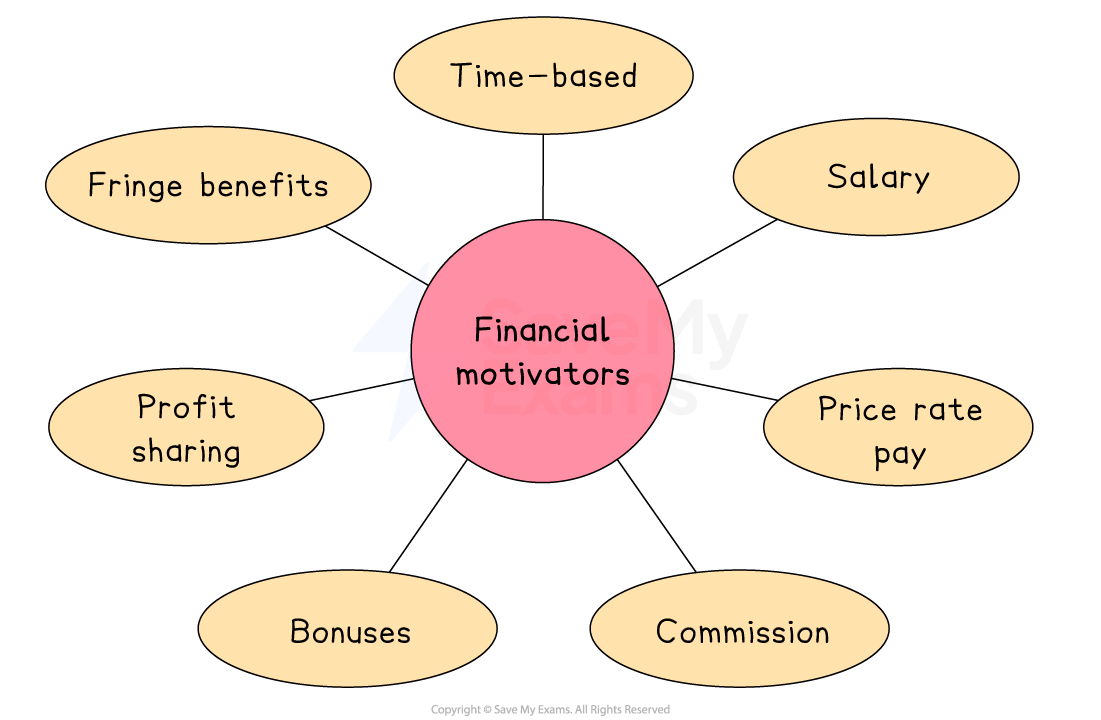Syllabus Edition
First teaching 2025
First exams 2027
Methods of Motivation (Cambridge (CIE) IGCSE Business): Revision Note
Exam code: 0450, 0986 & 0264, 0774
Financial methods of motivation
Financial incentives are rewards or payments given to employees in return for their labour or improved performance
The different theories of human motivation offer varying perspectives on the role of money in motivating staff
Herzberg's theory says that money is not generally a motivator, but the lack of it leads to dissatisfaction
Maslow's theory suggests people move through levels of needs that motivate them
Lower-order needs are closely linked to financial rewards, whilst higher-order needs are rarely linked to pay
Physiological and safety needs can be partially met by providing adequate pay
Love and Belonging needs are often met by encouraging aspects such as teamwork
Financial methods of motivation

Incentive type | Explanation |
|---|---|
Time based |
|
Salary |
|
Piece rate pay |
|
Commission |
|
Bonus |
|
Profit sharing |
|
Fringe benefits |
|
Examiner Tips and Tricks
Be careful not to confuse fringe benefits (like company cars or health insurance) with direct pay methods – they are still financial incentives, but given in non-cash form
Non-financial methods of motivation
Non-financial incentives are rewards that are not directly related to money
These incentives may be intangible and include methods that lead to recognition, praise, job satisfaction or improved work-life balance
Types of non-financial Incentives
Praise/employee of the month
Many workers respond well to praise or to recognition programs inside the workplace.
Meaningful praise can increase productivity
Job enrichment
Involves adding more challenging or meaningful tasks to a job
Staff feel more motivated and engaged, leading to improved productivity
Job rotation
Involves moving staff between broadly similar but varied roles in the business
Exposes staff to new challenges and experiences, which can increase motivation, understanding and skill
Teamworking
Teamwork may involve workers completing tasks together
Teamwork can increase motivation in the workplace, as each member of staff has a role and a shared goal
Training
Involves staff improving or learning new skills and abilities
This can make employees feel valued, more productive and likely to remain with the business
Promotion opportunities
Employees offered promotion will feel recognised, have a higher status and will be given more challenging tasks/responsibilities to perform
These benefits are closely linked to the views of both Maslow and Herzberg
Recommending motivation methods
When recommending a method of motivation for employees in a business, managers must recognise that individuals are motivated in different ways
Factors affecting the choice of motivation method
The context of the business
What type of business is it? E.g. manufacturing or sales
The budget available
How many workers does the organisation have?
Does the business currently use any methods of motivation?
What is the nature of the work carried out by employees on a daily basis?
The balance of the compensation package
Ideally it should include both financial and non-financial
It should be adaptable and reflect the changing needs of staff
Recommending a method of motivation
Case Study
Boosting Morale at ChocoBitz

ChocoBitz is a chocolate biscuit factory where employees worked long shifts on a fast-moving production line
Managers were concerned about poor motivation for several reasons
The work was repetitive and routine, and employees felt they were not learning new skills or progressing
Staff regularly complained about low rates of pay
This made workers feel bored and less engaged in their jobs
Staff turnover was high and increasing year on year
Solutions
To improve motivation, managers introduced job rotation
This allowed workers to switch between different tasks on the production line
This helped them build new skills, stay focused and feel valued
In addition, the business introduced a small performance-based bonus scheme
Workers who met or exceeded daily production targets received a cash bonus
This financial reward encouraged employees to stay productive and gave them an extra reason to remain with the company

Unlock more, it's free!
Did this page help you?